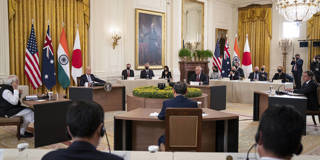The Indo-Pacific's four leading democracies can hold as many leaders’ summits as they want, but without a clear strategic vision – and an agenda to match – they will have little impact. The group’s purpose is to act as a bulwark against Chinese expansionism and ensure a stable balance of power in the Indo-Pacific.
NEW DELHI – When the Quad was first conceived as a strategic coalition of the Indo-Pacific’s four leading democracies, many doubted that it would amount to much. Chinese Foreign Minister Wang Yi mocked it as a “headline-grabbing idea” that would dissipate “like the sea foam in the Pacific or Indian Ocean.” But continued Chinese expansionism, combined with former Japanese Prime Minister Abe Shinzō’s determination to build broad resistance to it, has produced an increasingly consolidated group, with real potential to bolster regional security. The question is whether it will deliver.
One thing is certain: all four Quad members – Australia, India, Japan, and the United States – are essential to realize the vision of a “free and open Indo-Pacific” introduced by Japan in 2016 and affirmed by the US in 2017. While the Quad took some time to get off the ground – it was resurrected during US President Donald Trump’s administration but leaders’ summits began only after Joe Biden took office – it has gained considerable momentum. Its members have held three summits since last year (two of them virtual) and are set to meet in person in Tokyo on May 24.
But the Quad still has a long way to go, not least because its members’ own actions are undercutting its strategic rationale – the need to prevent China from upending security in the Indo-Pacific. A key problem is that all four countries have allowed themselves to be seduced by the Chinese narrative that economic relations can be separated from geopolitics.

NEW DELHI – When the Quad was first conceived as a strategic coalition of the Indo-Pacific’s four leading democracies, many doubted that it would amount to much. Chinese Foreign Minister Wang Yi mocked it as a “headline-grabbing idea” that would dissipate “like the sea foam in the Pacific or Indian Ocean.” But continued Chinese expansionism, combined with former Japanese Prime Minister Abe Shinzō’s determination to build broad resistance to it, has produced an increasingly consolidated group, with real potential to bolster regional security. The question is whether it will deliver.
One thing is certain: all four Quad members – Australia, India, Japan, and the United States – are essential to realize the vision of a “free and open Indo-Pacific” introduced by Japan in 2016 and affirmed by the US in 2017. While the Quad took some time to get off the ground – it was resurrected during US President Donald Trump’s administration but leaders’ summits began only after Joe Biden took office – it has gained considerable momentum. Its members have held three summits since last year (two of them virtual) and are set to meet in person in Tokyo on May 24.
But the Quad still has a long way to go, not least because its members’ own actions are undercutting its strategic rationale – the need to prevent China from upending security in the Indo-Pacific. A key problem is that all four countries have allowed themselves to be seduced by the Chinese narrative that economic relations can be separated from geopolitics.